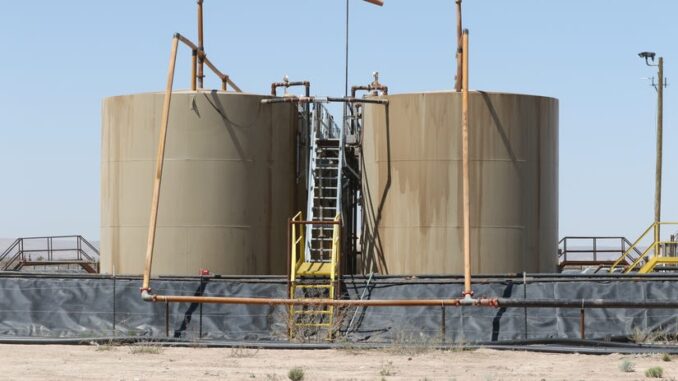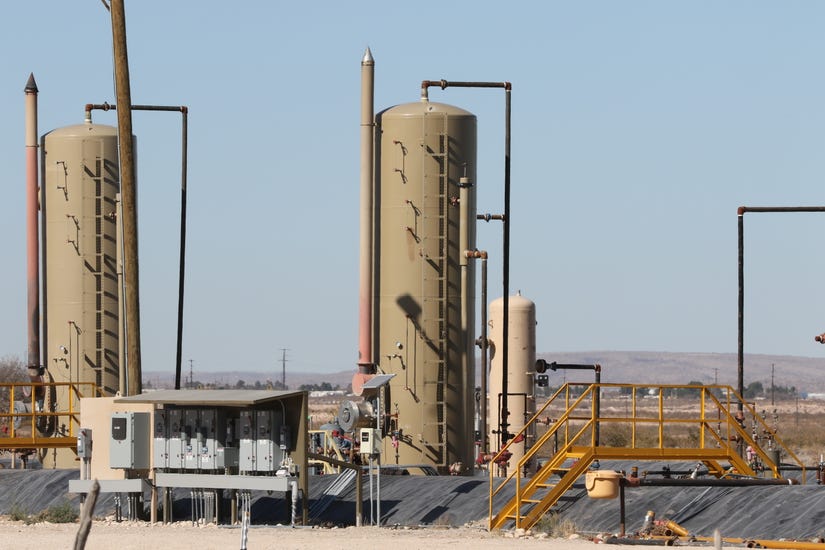
A global oil and gas giant sought to eliminate most flaring in the next five years, led by a facility in the Permian Basin.
BP announced it was moving toward zero routine flaring, or the burning off of excess natural gas, by 2025 this week, and that it was building an electrified oil, gas and water handling facility in Orla, Texas near the state’s border with New Mexico.
Flaring can be used as a cost-saving measure by operators without the capacity to send all their produced gas to market, or as a safety precaution to ensure safe pressures at oil and gas facilities.
The Grand Slam facility replaced gas-driven equipment, compressors, and generators with electrified components, per a BP news release, and was intended to lead the fossil fuel giant’s push to reduce emissions in one of the world’s most prolific onshore oil and gas plays.
It was operational last June, about $300 million of BP’s planned $1.3 billion investment in infrastructure to reduce emissions, per reporting from the Wall Street Journal.
By the end of 2021, BP expected 75 percent of its operated wells in the Permian – spanning southeast New Mexico and West Texas – would be similarly electrified, and more than 95 percent by 2023.
The company also reported it was improving its methane detection and monitoring programs using drones and aerial equipment using infra-red imaging.
BP’s recent efforts followed its $10.5 billion acquisition of BHP’s shale assets in the basin which created BPX Energy to oversee BP’s onshore oil and gas operations and lead the work to reduce emissions.
Since those assets were acquired, BP reported its flaring intensity – or the amount of gas flared per unit of energy produced – declined from about 16 percent in 2019 to less than 2 percent as of April 2021.
“What we are doing with our Permian assets is a clear example of our strategy in action. Electrification of the field has been a gamechanger,” said Kim Krieger, vice president of operations at BPX Energy
“We are cutting emissions while significantly increasing the reliability of our field operations enabling a 20 percent uplift in production. It’s exciting to see our emissions decrease and our incremental operating cash flow increase.”
BPX Vice President of Low Carbon and Sustainability Faye Gerard said the company continued to seek new technologies to support its goal of becoming a “net zero company” in the next 30 years.
“Our journey is just beginning. We still have work to do, but we are constantly evaluating and piloting new technologies to help further reduce emissions, including flaring, and help advance BP’s ambition to be a net zero company by 2050 or sooner,” Gerard said.
Moving toward lower carbon operations for BP was following global industry trends as companies and policy makers recently sought to address pollution and climate change, said Chairman of BP America Dave Lawler.
He said the shift was needed for the industry and its leaders to remain sustainable into the future.
“We see a future where our Permian production is a highly commercial and low carbon energy resource that uses a combination of technologies – such as continuous methane monitoring, electrification, and block chain applications – to support and accelerate the energy transition,” Lawler said.
“Embracing these technologies goes well beyond a fractional improvement, as we look to these resilient hydrocarbons to help fuel BP’s transition to a net zero company.”
Industry efforts did see success in the last year, per a report from energy industry analytics firm Rystad Energy which showed flaring in the basin reached its lowest levels as of January 2021 since 2017 even as fracking operations returned to pre-COVID-19 levels.
Rystad reported Permian flaring intensity fell below 1 percent at the start of this year, crediting the decline to efforts by producers like BP to respond to investor concerns and reduce their carbon footprints.
Colin Leyden, director of regulatory affairs for the Environmental Defense Fund based in Austin, Texas said BP’s efforts and those of other operators were encouraging and in response to demands from investors and the public alike.
“I think the companies are reacting to some pretty intense investor pressure as well as public pressure,” he said. “I think companies who are public or dependent on investment funds understand that flaring is sort of a visual representation of how a company is performing environmentally.”
Leyden also pointed to a recent commitment from another Permian Basin operator Apache Corporation which vowed to end routine flaring by 2021.
He said 10 to 11 percent of methane pollution in the basin comes from flaring and that companies must devise plans before they drill a well for where the gas will go.
“It comes down to the concept that you’re not going to drill and oil well unless you have a place to send the gas,” Leyden said. “That needs to become the new operating norm.”
But even when upstream producers or oil and gas work to change how they handle natural gas, improvements also need to be made in midstream infrastructure to reduce emissions throughout the supply chain, Leyden said.
“A good chunk of the flaring is driven by problems with the midstream sector. They look at that as health and safety which is true. But at the same time, it’s not just occasional things that happen, it’s regular occurrence,” he said.
“What we’ve seen is a systemic failure in the midstream sector so we’re seeing regular health and safety flaring, and that’s the next big chunk.”




